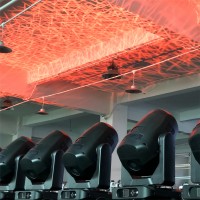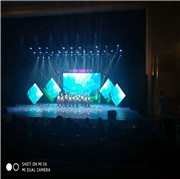#QuietTheatreLight #Noise #TheatreLighting #QuietLight #QuietMovingHead #MovingHead #Quietstagelighting #QuietLight
When you see the question, you know the answer intuitively:NO.
But let me tell you that there is noise when any stage lighting is working, unless you don't use lights.
When you watch a performance in a theater, your goal is to enjoy the content without unnecessary interference, right? As an essential part of the stage, moving head lights are prone to noise interference. Stage lights, like everything from personal computers to cars and airplanes, require active cooling to ensure optimal performance. With the continuous improvement of stage lighting technology, stage lighting components now produce much less sound than in the past, but if you want to buy stage lighting, you need to accept the fact that fans and moving parts do make sounds. But this should never hinder your theater experience. We are not talking about the booming sound of the factory here, but we often hear the sound of moving head lights cooling and rotating parts, just like using a computer host with a chassis fan and a platter drive.
Many of my professional customers, especially theater customers, the first topic with me was definitely not the price, but the noise. It can be seen that they have very strict requirements on the noise of the lights. Unfortunately, there are still many lighting manufacturing companies that do not pay much attention to noise in their design.
Today, I will discuss with you where is the noise source of moving head lights, how do we distinguish silent moving head lights, and how to use moving head lights in theaters to achieve the smallest noise.
One platitude concept of noise:
See the picture below,we will understand our reaction to noise:
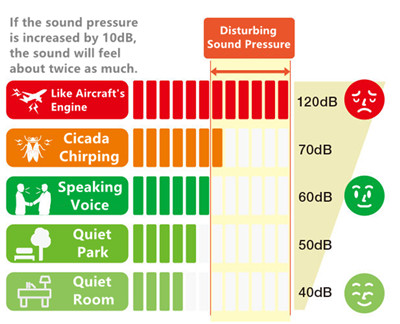
Imagine that during a performance, the microphone also recorded and played the noise of the lights. That would be embarrassing to buy more, enough to ruin a performance!
(Ⅰ) The noise of moving head light generally comes from several places:
1. Fan,
Who would like the "boom boom" sound? Fans are an important source of noise, with mechanical sounds and wind speeds in the middle.
It should be emphasized that there are 2 main parts for the fan of the moving head light: the light source and the power supply. They are both large heat sources. Another theme facing active cooling: noise.
The fan of the light source of the light holder, its role is to dissipate the high heat of the light source, so that the light source continues to maintain a constant light output, which is the main cause of noise.
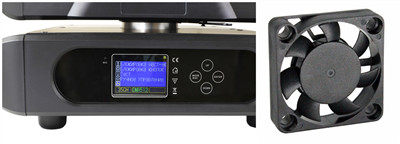
The other is the fan of the base, its role is to dissipate the heat of the power supply, so that the power supply can work normally, and provide stable power for the whole light (especially the light source).
Some factors that usually cause noise from cooling fans are:
1). The cutting wind noise of the fan blade at high speed
2). The air duct impedance is too high and the fan works in the stall area and beyond
3). Obstacles cause turbulent flow noise
Simply summarize:
Motor Noise:
·Electromagnetic Noise
Mechanical Noise:
·Bearing Noise
·Vibration Noise
Fluid Noise:
·Wind Cut Noise
·Turbulence Noise
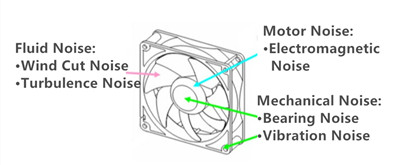
Therefore, it is not a simple task to consider the heat dissipation of the light source and power supply and equip the corresponding quiet fan.
2. The radiator also affects the noise of the stage lights, although it is not a direct factor.
The radiator is generally closely connected with the light source.
There are mainly two kinds of radiators popular in the moving head light market, aluminum radiators and copper tube radiators.
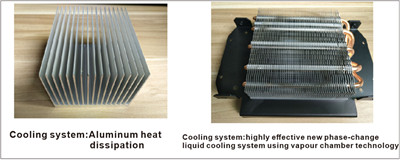
The cooling system does not produce noise, but due to the difference in cooling system efficiency, the speed of the cooling fan is also different, which may cause noise.
The heat losing efficiency of the aluminum cooling system is lower than that of the copper tube cooling system, so, the possibility of causing noise is increased.
The principle of the copper pipe cooling system, to put it simply, is to use the excellent thermal conductivity of the copper pipe and the condensation and transformation of the liquid in the copper pipe to output heat. The copper tube cooling system increases the heat dissipation area, the overall heating speed is relatively slow, and the heat dissipation speed is relatively faster. The high-power operation of the fan will be less, and it will naturally be quieter.
3. Various movements may produce noise, especially if the parts are changed after transportation, or after a period of use. For example, horizontal scanning of the light head, vertical scanning, CMY, CTO, zooming in and out, etc., may cause noise due to the insufficient connection of the components. Opening the shell to check and adding smooth oil is an excellent solution. Under normal circumstances, when the moving head light is used naturally, the noise of the moving part is minimal.
(Ⅱ) How should I distinguish silent lights?
The easiest way, use our ears to judge. We put the light in a quiet room and eliminate the interference of other noises, and then we can hear the noise of the light. It should be noted that the noise is produced by every normal light, and the noise level is determined after we compare different stage lights.
The most accurate method is to use a volume meter.
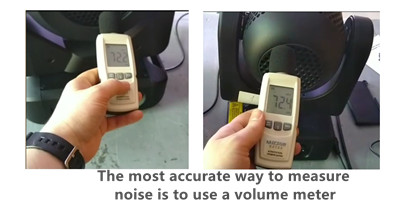
First of all, when the moving head light is turned on and the brightness is adjusted to the maximum (we call it "full power"), we use a volume meter.
You don't have a volume meter on your hand, you can install an APP on your phone, such as "myNoise", "Decibel X",”Sound Meter Pro” you can measure the volume normally. Of course, there is a certain error with the professional volume meter.
In the noise test, the short-distance and 1-meter distance tests are the most common. We are used to measuring at close range. Of course, some customers like the measurement of 1 meter distance. They are not much different, about 3-10dB.
As a result of the measurement, we will look at the average dB value (note that it is "average", not the maximum or minimum dB value). If it is average less than 45dB, it is a very quiet category, you can use it in the theater with confidence; if it is 80-45dB, it is used in the theater, and you need to be far away from the microphone or the actor to ensure that the microphone cannot record noise, and the actor will not Affected by noise.
https://www.linkedin.com/pulse/moving-head-light-noise-acceptable-use-quiet-theatre-setting-luo
(领英相关文章)
(Ⅲ) How to use moving head lights to achieve the minimum noise in the theater.
When using moving head lights, pay attention to the following points, which are a good way to improve noise.
1.Keep the distance between the light and the wall above 50cm
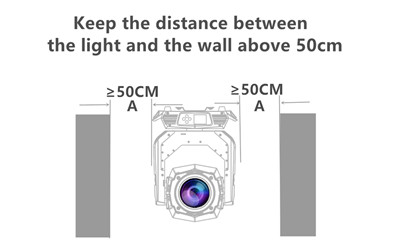
2. Moving head lights prefer a cool environment. Just like refrigerators or freezers don't like hot high temperatures, so do moving head lights. We test the sound level of all our stage lights at 23-27 degrees Celsius, which is our recommended range. If the temperature of your lighting environment exceeds 27 degrees, the stage lights may need to work harder to stay cool, resulting in a slight increase in sound output.
3. Make sure that the ventilation holes of the stage lights are not blocked. I remember one of our customers (a relatively impressive case), he repaired a stage light that had been used for 3 years, because it had been working next to a smoke machine for a long time, and the ventilation holes were seriously blocked by smoke, and the noise was like the sound of covering his mouth. . When we cleaned up, there was almost no abnormal noise.
4. In recent years, many stage lighting manufacture companies have added "Quiet Mode" to the function (some menus display "Theater Mode") in response to theater application scenarios. You can adjust the brightness and fan noise by selecting the fan mode. For example, for this 7*60W LED moving head light, the menu contains 3 fan mode: NORMAL/PERFORMANCE/QUIET. Among them, NORMAL is a normal fan mode, suitable for general occasions; PERFORMANCE is an efficient fan mode, the brightness of the lamp will be higher, and the noise of the fan will be higher. It is suitable for those what have high requirements for brightness but are not sensitive to noise occasions, such as a fast-paced singing stage; QUIET, as the name suggests, is a quiet/theater mode, suitable for noise-sensitive theaters, the brightness will be darker, but the fan noise will be reduced.
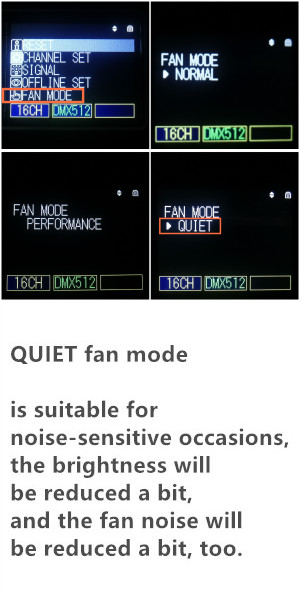
Through the above introduction, you can easily know the key to quiet stage lights in theaters, which will prevent unnecessary noises and prolong the life of the stage lights. Happy next time you watch a performance in the theater!


